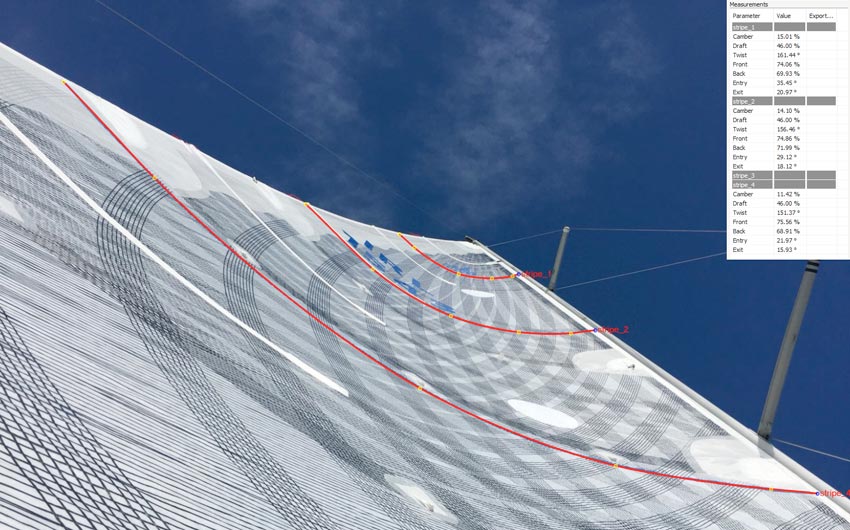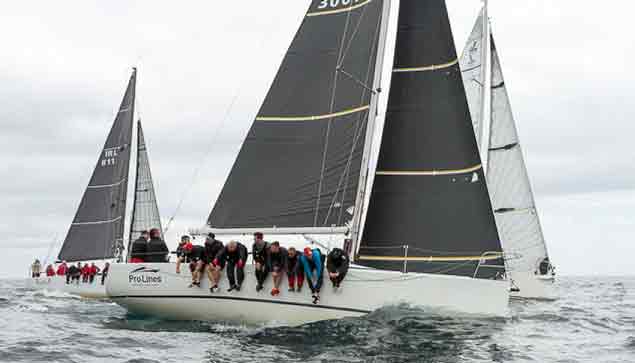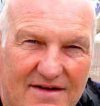Mark Mansfield, Racing Consultant for UK Sailmakers Ireland, previously wrote about tuning a fractionally rigged mast. In this latest article, in association with ICRA, the four time Olympian describes how to set up the mast and sails for best performance upwind in different wind conditions
BASICS
The first article dealt with getting your mast in a basic good position, centralised sideways, the correct basic rake, the correct shroud tension and finally the correct prebend. This should always be done in medium wind conditions in what we would call the 'base position', normally 11 to 15 knots. It is assumed that once this initial base wind tuning has been done, the sails, when set, fit the mast prebend properly.
By this, I mean when going upwind in say, 12 or 13 knots the mainsail looks to be in a good aerofoil shape (see photo below), with a little bit of backstay tightened. No overbending would be evident (wrinkles running from the mainsail clew to the middle of the mast). Likewise the mainsail in these conditions should not look too full.
It is important to get the mainsail right in these conditions as sometimes the main might just be cut too flat or be just too full and may need a small alteration to the luffround by your sailmaker. When you pull on a lot of backstay in these 12/13 knots conditions, if you still do not get overbend wrinkles, as stated above, the chances are that the main has too much luffround and needs a bit taken out.
On the other hand, if, in 12/13 knots of wind, you get overbend wrinkles immediately you put on a small amount of backstay, it is likely the mainsail is too flat in the luff and will need some luffround added by your sailmaker. These are not very difficult adjustments for a sailmaker and can really make a difference. It is possible to adjust the rigging a bit to help rectify these problems, but really it can often lead then to further issues. So, say your main is looking a bit deep and you ease the lower shrouds to allow the mast to bend forward more, then the mast, in addition to bending further fore and aft also bends sideways to leeward. This, then in slightly stronger winds closes the slot between the main and jib and can be slow.
It is very rare that a mainsail will look fantastic in light, medium and strong wind conditions. As a general rule you design a main, for Irish conditions, to be best in moderate winds and you then either live with it in the other conditions or you adjust the rig to try and get the rig to fit the sail in those light and heavy conditions.

BASE WIND ADJUSTMENTS
All right, let's say the Main does now fit the Mast (either it was right or has been altered by your sailmaker). In these base (11 to 15 knots) winds you are going upwind nicely, with all your crew on the rail and hiking (hopefully hiking hard—really important). What should be evident is your headstay should be moderately tight, maybe a little bit of fall off, your mainsheet should be fairly tight with the top leech telltail streaming most of the time. Your backstay will be tightened a bit and as the wind ranges from say 11 to the 15 knot base range, you will be adjusting your backstay (tighter in the stronger range and less in the lower range). As you tighten backstay, the mainsheet needs to be pulled on more and because this pulls the mast back, it will open the jib leech, so normally the jib needs to be sheeted in more or maybe the jib lead moved forward. As the breeze increases, a telltail sign that you need to tighten backstay is if the helm gets heavy.
Conversely, if the breeze eases and the helm feels a bit dead, then easing the backstay will give you power. But remember, this then will likely require the mainsheet to be eased and the jib sheet eased. I will discuss the importance of the helm feel later.
One adjustment I have not mentioned yet is the main traveller. Up until weather helm becomes excessive, the traveller can be kept in the middle or even to weather. In lighter airs, you can keep the traveller well to weather, and even the boom can be above centerline. My rule of thumb in light air is to have the mainsail clew, (about a foot or two up the leech), in the centre. This may mean the boom is a bit above the centreline but most of the sail is not and that will give you more power and feel on the helm which is very important in light winds. In the higher end of this base (11-15knots) wind range, you may need to leave the traveller down below the centerline to ease weather helm. Try backstay on first though which will tighten the forestay and flatten the sail plan. If this still results in too much helm, then drop the traveller, but only 400 mm or so to leeward of centre. Dropping it too much just closes the slot between the main and jib and leads to a lot of mainsail backwinding which is slow. The reality is if you are overpowered to the level of dropping the traveller further, you really should be on a smaller or flatter Jib. Likely though, in these 11- 15 knot winds you will not be that overpowered.
Below this wind range (less than 10 knots) you are looking for power in order to get all the crew fully on the rail and hiking. Above the base wind range (over 15 knots), you are depowering the boat upwind by flattening and twisting the sails.
 The weight on the helm is extremely important. As a general rule, 5 or 6 degrees of weather helm is what you are looking for Photo: Afloat.ie
The weight on the helm is extremely important. As a general rule, 5 or 6 degrees of weather helm is what you are looking for Photo: Afloat.ie
HELM
The helm is the most important indicator of whether the boat is set up correctly or not. It will talk to you, if you listen. Most of my sailing career has been as a helm, Admiral's Cups in the 80’s, one designs in the 90’s (Olympics in Stars, 1720’s, Melges 24's, Mumm 30’s), Commodores Cup etc in the last 10 or 15 years. The weight on the helm is extremely important. As a general rule, 5 or 6 degrees of weather helm is what you are looking for. A bit of weather helm, though it adds drag, is good. The rudder, when it is angled 5 or 6 degrees will give the boat lift. It is not just the keel that gives lift, so does the rudder. If you have neutral helm, chances are you are not pointing that well, and if you have too much helm, chances are you are going slow. If you are wheel steered, put a mark on both sides of central to show what 6 degrees of helm represents. If a tiller, work out also what 6 degrees relates to.
The best mainsheet trimmers, you will find, were also helms. You will see them constantly looking at the helm while they are trimming the main to try and keep the helm in the correct position. If they were helms you will find that they understand what your problems are very early on and will try and address them quickly. It is also very important for a helm to communicate with the mainsheet trimmer what he/she is feeling from the helm.
 It is very rare that a mainsail can look fantastic in light, medium and strong wind conditions. As a general rule you design a main, for Irish conditions, to be best in moderate winds and you then either live with it in the other conditions or you adjust the rig to try and get the rig to fit the sail in those light and heavy conditions Photo: Bob Bateman
It is very rare that a mainsail can look fantastic in light, medium and strong wind conditions. As a general rule you design a main, for Irish conditions, to be best in moderate winds and you then either live with it in the other conditions or you adjust the rig to try and get the rig to fit the sail in those light and heavy conditions Photo: Bob Bateman
FORESTAY
Another indicator of whether the boat is set up correctly or not, in addition to the helm, is how the forestay looks. In lighter airs, you want the forestay to have some sag, as this will build power, which will add lift also. As the breeze increases, to say 10 knots or so, tightening the mainsheet will automatically tighten the forestay a little. While all this is happening the backstay will just stay snug. Don’t have the backstay flopping around as this will result in the forestay pumping forwards and backwards in the waves. Until the helm starts to get heavy, it is still good to have some forestay sag. If the forestay tension was set correct initially you will find that as the wind increases from light to medium, the amount of sag in the forestay should decrease just nicely as you initially take on extra mainsheet and then eventually start to take on backstay. As the breeze gets to 14 or 15 knots or so, you generally want the forestay pretty straight as you are now starting to depower a bit. If you are depowering, then a straight forestay means you can point higher.
RIG CHANGES OUTSIDE BASE
All of the above discussion is based on not changing the Standing Rigging (forestay and shrouds) in different wind conditions. For most racing boat owners they will be just happy to get a good base setting and will lock off the shrouds and forestays with rigging pins. In this situation they will be happy with maybe being a little underpowered in the lighter airs and will live with being a bit overpowered in the stronger winds.
However there are good gains to be made in adjusting the rig regularly. Perhaps only 25% or so of boats in Ireland that race at a good level will adjust their rigging for different wind conditions, but you will likely find that most of these will end up towards the top of the fleet.
I normally will have five rig settings:
- 0-7 kts—very light--all crew normally down to leeward—soften and ease rig a lot
- 8-11 kts-transitioning—few crew to weather early and then all – softer than base
- 12-15 kts – Base – (see above)
- 15-20 kts—Depowering a bit. Tighter than Base
- 20 kts and above—Full on powered up, very tight rig
In my next article, I will go through the options to getting to these lighter and heavier rig tensions and what each change of the rig will bring. I will show a chart we have done for a well known one design, the J109, showing what to do in each of these conditions and most importantly will explain, once the shrouds and forestay are adjusted, how to set the sails to maxamise these Rig changes. This chart, though aimed at the J109, will be similar for most cruiser racers.
I will also offer an intermediate option to adjusting all your shrouds and forestay that will be nearly as efficient and will be more easily reproduced. The problem with changing all your shrouds and forestay in each condition is that in very many cases you lose track of what setting you are on. Also, as happens a lot, often someone tightens a bottlescrew when they think the are loosening it which leads to S bends appearing in the mast. Fair Sailing – Mark Mansfield
 Article author Mark Mansfield Photo: Afloat.ie
Article author Mark Mansfield Photo: Afloat.ie
In addition to being a self employed sailing Consultant for UK Sailmakers Ireland, Mark Mansfield is a Professional Sailor. He has been competing for 35–years on the International stage including four Olympics in the Star Class, four Admirals Cups in the 80’s, Commodores Cups in the last ten years and numerous other One Design and big boat campaigns. He has a specialisation in rig tuning and has tuned many of the top racing yachts in Ireland. He also is a noted tactician and was tactician on boats which have won their class in the last 3 ICRA nationals, the last three Volvo Dun Laoghaire Regattas (incl overall boat in 2017), IRC Europeans winner, Cowes Week winner, Spi Ouest winner, Cork Week, Scottish Series, UK IRC winner etc. He is a two times Irish Sailor of the Year and a two times Irish Helmsmans Champion. He is available to sail with, coach, tune rigs or advise on rating improvements for any boat, whether they use UK sails or not. Contact Mark at [email protected] or mobile: 087 2506838
Other articles in the UK Sailmakers Ireland/ICRA 'How to...' Series:



























































